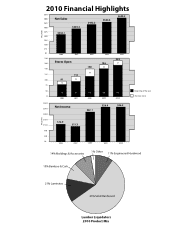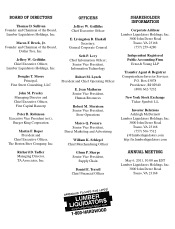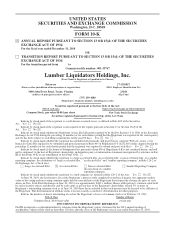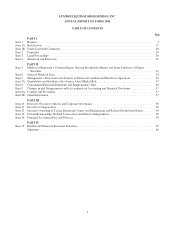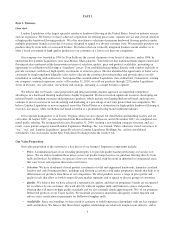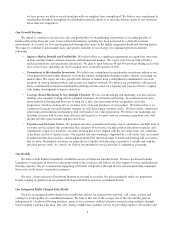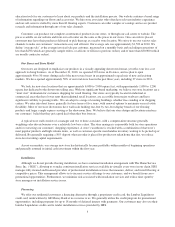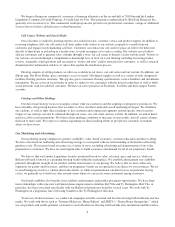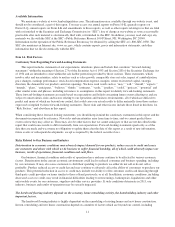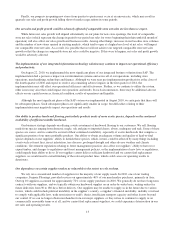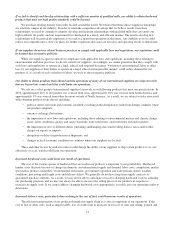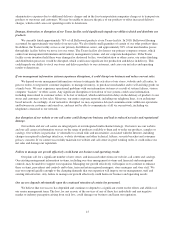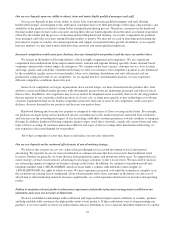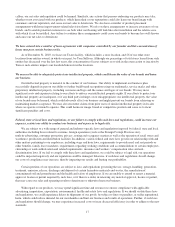Lumber Liquidators 2010 Annual Report Download - page 15
Download and view the complete annual report
Please find page 15 of the 2010 Lumber Liquidators annual report below. You can navigate through the pages in the report by either clicking on the pages listed below, or by using the keyword search tool below to find specific information within the annual report.We ship our products to our stores over the road by truck or over rail using an intermodal service. We expect each store
to receive a truckload of product at least once per week. Further, we now work closely with certain suppliers to ship selected
key product, including moldings and accessories, directly to our stores.
We continue to evaluate logistics alternatives to best service our store base. We believe that our existing facilities will
continue to play an integral role in our strategy, and expect future expansion of alternatives, if any, to be leased locations,
with related expense no earlier than 2012.
Our Market
According to industry sources, the hardwood flooring market represents approximately 9% – 10% of the overall U.S.
floor coverings market, which includes carpet and area rugs, hardwood and softwood flooring, ceramic floor and wall tile,
resilient sheet and floor tile and laminate flooring. In its December 2009 Wood Flooring report, Catalina Research, Inc.
(“Catalina”) estimated that the retail value of U.S. hardwood flooring had decreased to approximately $3.1 billion from $4.0
billion in 2007. Considering our sales mix of hardwood flooring, we estimate our 2010 market share at approximately 12% –
13%, up from 11% – 12% in 2009 and 8% – 10% in 2008.
The laminate flooring market is estimated to represent approximately 5% of the overall U.S. floor coverings market. In
its December 2010 Floor Covering Industry report, Catalina estimated that the wholesale value of U.S. laminate flooring in
2009 was approximately $900 million. Considering our sales mix of laminate flooring, we estimate our 2010 market share at
approximately 8%, up from approximately 6% in 2009 and 3% in 2008.
The wood flooring market for homeowners is highly fragmented. Catalina estimates that Lumber Liquidators, Home
Depot and Lowes together represent approximately 35% of the hardwood flooring retail sales with the remaining sales
coming predominantly from regional and local independent retailers and smaller national chains. The wood flooring market
for homeowners is dependent on home-related discretionary spending, which is impacted by a number of complex economic
and demographic factors that may vary locally, regionally and nationally. We are impacted by, among other things, home
remodeling activity, employment levels, housing turnover, real estate prices, new housing starts, consumer confidence, credit
availability and the general health of consumer discretionary spending. Many of the economic indicators associated with the
wood flooring market and generally associated with consumer discretionary spending remain weak. Catalina projects the
hardwood flooring market will only average annual growth of 3% per year 2011 – 2015.
We believe the number of retailers serving the homeowner-based segment of the wood flooring market continues to
shrink under the difficult macroeconomic pressures. We believe our results have benefited from our gain of market share in
this environment and that we will continue to gain market share, primarily through new store openings. We continue to
believe that the longer term trends for our market remain favorable, including customer perception of hardwood flooring as
an attractive alternative to other floor coverings, the evolution of the hardwood flooring market, overall home improvement
spending, and certain demographic trends.
Our Competition
We are the largest specialty retailer of hardwood flooring in the United States, and compete in a hardwood flooring
market that is highly fragmented. The market includes both national and regional home improvement chains which specialize
in the lower-end, higher-volume flooring market and offer a wide range of home improvement products other than flooring.
We also compete against smaller national specialty flooring chains, some of which have an Internet presence, and a large
number of local and regional independent flooring retailers, including a large number of privately-owned single-site
enterprises. Most of these retailers purchase their hardwood flooring from domestic manufacturers or distributors, and
typically do not stock hardwood flooring, but order it only when the customer makes a purchase. As a result, we believe it
takes these retailers longer than us to deliver their product to customers, and their prices tend to be higher than ours. We also
compete against companies that sell other types of floor coverings, such as carpet, vinyl sheet and tile, ceramic tile, natural
stone and others.
Seasonality and Quarterly Results
Our quarterly results of operations fluctuate depending on the timing of our advertising expenses and the timing of, and
income contributed by, our new stores. Our net sales also fluctuate slightly as a result of seasonal factors. We experience
9


